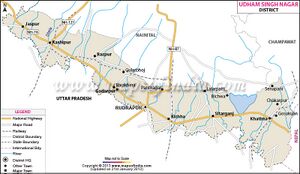Rudrapur Uttarakhand
| Author:Laxman Burdak, IFS (R) |

Rudrapur (रुद्रपुर) is a city in Udham Singh Nagar district in the Indian state of Uttarakhand. Rudrapur is known as the 'Gateway to Kumaon', which is in close proximity to regional attractions like Nainital, Corbett National Park, Bhimtal and Almora.
Location
Located at a distance of about 250 km northeast of New Delhi and 250 km south of Dehradun. Rudrapur is located in the fertile Terai region over an area of 27.65 km2.
Origin of name
It is believed to be named after the King Rudra Chandra who was handed over this region by the Emperor Akbar in 1588.[1]
History
Rudrapur has a history of over 500 years. It was established in the 16th century by King Rudra Chand, and was the residence of the governor of Tarai region of Kumaon. The city continues to serve as the headquarters of the Udham Singh Nagar district apart from being a major industrial and educational hub today.
In this area, some artesian water wells produce water under pressure and no pump is required. The Terai area, where Rudrapur is located was considered an impenetrable forest for much of the ancient period. Marshy land, extreme heat, rains which lasted months, wild animals, diseases and no means of transportation prevented people from settling here. No historical settlements, except Govishana (50 km northwest of the city), has been recorded in the area.[2] Mughal historians mention that the Chand ruler of Champawat, Gyan Chand, visited Delhi Sultanate and received the regions of Bhabar–Terai up to the Ganges as a grant from then Sultan; thus bringing it under the Kingdom of Kumaon. This area remained under local chieftains; it was Kirti Chand (1488–1503), who first ruled the Terai area, along with the rest of Kumaon.[3]
Rudrapur town was established in the 16th century by King Rudra Chand of Almora.[4] It was the residence of the Adhikari (Governor) of Tarai, till the town of Kashipur was Established in 1718.[5] The Kumaoni Army, under Shiv Deo Joshi faced severe defeat during the Battle of Rudrapur, that was fought between Chands and Rohillas in AD 1744.[6] Later, King Deep chand built a fort at Rudrapur to keep vigil over the Rohillas.[7]
By the end of Eighteenth century, Nand Ram, the Adhikari of Kashipur, murdered the governor of Rudrapur, Manorath Joshi, and declared himself the de facto ruler of the low-lying Terai land, with his capital at Kashipur.[8] After the fall of Almora in 1790, Rudrapur and its surrounding areas were ceded to the Nawab of Oudh, who remained its suzerain until the British occupation in 1801.[9]
रुद्रपुर परिचय
रुद्रपुर : उत्तराखण्ड राज्य में उधम सिंह नगर जनपद का एक नगर है। यह दिल्ली, तथा देहरादून से 250 एवं हल्द्वानी से 29 किलोमीटर की दूरी पर स्थित है। रुद्रपुर उत्तराखण्ड का एक प्रमुख औद्योगिक और शैक्षणिक केंद्र होने के साथ साथ उधम सिंह नगर जनपद का मुख्यालय भी है।
इतिहास: रुद्रपुर नगर की स्थापना कुमाऊँ के राजा रुद्र चन्द ने सोलहवीं शताब्दी में की थी, और तब यह तराई क्षेत्र के लाट (अधिकारी) का निवास स्थल हुआ करता था। रुद्रपुर नगर की स्थापना अल्मोड़ा के राजा रुद्र चंद ने सोलहवीं शताब्दी में करी थी। दक्षिण के मुस्लिम राजाओं द्वारा तराई क्षेत्र में लगातार हो रहे आक्रमणों से निजात पाने के लिए उन्होंने रूद्रपुर में एक सैन्य शिविर की स्थापना की। बाज बहादुर चन्द के राज के समय से तराई क्षेत्र के लाट (अधिकारी) का निवास भी यहाँ ही हो गया। 1744 में चन्दों तथा रुहेलाओं के बीच लड़ी गयी रुद्रपुर की लड़ाई में शिव देव जोशी की अगुवाई में कुमाउँनी सेना को गंभीर हार का सामना करना पड़ा था। इसके कुछ वर्षों बाद राजा दीप चन्द ने रुहेलाओं की गतिविधियों पर नज़र रखने के लिए रुद्रपुर में एक किले का निर्माण किया।
अठारहवीं शताब्दी के उत्तरार्ध में, काशीपुर के लाट नंद राम ने रुद्रपुर के अधिकारी मनोरथ जोशी की हत्या कर दी, और काशीपुर में अपनी राजधानी स्थापित कर स्वयं को निचले तराई क्षेत्रों का शासक घोषित कर दिया। 1790 में अल्मोड़ा के पतन के बाद, उसने रुद्रपुर और उसके पूर्व की ओर स्थित क्षेत्रों को अवध के नवाब को सौंप दिया गया, जिनका अधिपत्य इन क्षेत्रों पर 1801में अंग्रेजों के कब्जे तक रहा।
Notable persons
References
- ↑ https://usnagar.nic.in/history/
- ↑ [https://archive.org/details/journalasiatics30benggoog Journal of the Asiatic Society of Bengal. Asiatic Society. pp.174–175
- ↑ Imperial Gazetteer of India, Vol.18, p.324.
- ↑ Rawat, Ajay S. (1998). Forest on fire : ecology and politics in the Himalayan Tarai. New Delhi: Cosmo Publications. ISBN 9788170208402. p.6
- ↑ Hāṇḍā, Omacanda (2002). History of Uttaranchal. New Delhi: Indus Publishing. ISBN 9788173871344.,p.81
- ↑ Hāṇḍā, Omacanda (2002). History of Uttaranchal. New Delhi: Indus Publishing. ISBN 9788173871344.,p.92
- ↑ [Hāṇḍā, Omacanda (2002). History of Uttaranchal. New Delhi: Indus Publishing. ISBN 9788173871344. p.95
- ↑ Pande, Badri Datt (1993). History of Kumaun : English version of "Kumaun ka itihas". Almora, U.P., India: Shyam Prakashan. ISBN 81-85865-01-9.,p.320
- ↑ Imperial Gazetteer of India, Vol.18, p.325

